Along with our environmental policy, we have also developed a safety policy to protect the welfare of all our stakeholders. We have adopted safety measures for our contractors, our residents and our staff.
This year, we continued to implement the Housing Authority Safety Audit Scheme (HASAS), developed and operated since 1996 to assess site safety performance of our contractors. We applied this to over 30 piling, demolition, site formation and building contractors resulting in a safety audit score. These scores are linked to payment under the Pay for Safety, Environment and Hygiene Scheme (PSE&H), wherein contractors are only paid if their audit scores are 70% or above; and serve as critical considerations leading to suspension from tendering.
A pilot project has been undertaken at the Kwai Chung Flatted Factory to significantly increase the use of precasting and prefabrication from our usual levels of 18% to over 60%, a construction method that will enable safer and cleaner site conditions as on-site construction work and wastes generated from our construction processes are minimized.
| Safety awareness and best practices are promoted through safety seminars and support of the safety publicity campaigns. We are proud to say that many of the major safety awards were won by contractors undertaking Housing Authority construction projects. These awards reflect the effectiveness of safety practice on our sites. |
Our safety indicators demonstrate that our safety initiatives and programmes are successful. In fact, safety data for 2005/06 showed improved performance in all Housing Authority contracts, new works, and maintenance works. For example, the accident rate for new works per 1,000 workers has decreased from 55.8 in 2001/02 to 21 in 2005/06, which is significantly lower than the average accident rate for the construction industry in Hong Kong (59.9 per 1,000 workers in 2005, Labour Department, HKSAR Government).

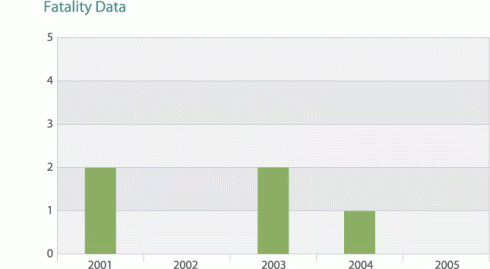
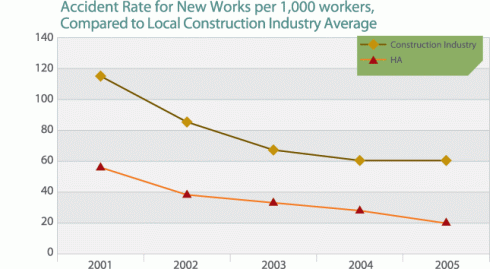
Safety in our estates has always been a priority. As such, we have developed and implemented, among others, the following policies and programmes to ensure the health and safety of our tenants.
Highlights in 2005/06 include:
Housing Estates
-
Implementation of the Total Maintenance Scheme ;
-
Initiation of a HK$68 million maintenance programme of aluminium windows in 140,000 Public Rental Housing (PRH) flats in 213 Harmony blocks in over 53 estates built before 2000 and a general public alert on window safety;
-
Replacement of worn or damaged fire service installations, launch of the Estate Fire Safety Campaign mini website in August and organization of our annual Fire Safety Roadshow which involved over 11,000 public housing tenants;
-
Improvements by the installation of handrails and pedestrian ramps in older estates to facilitate access by the elderly and disabled; and
-
Banning of wax burning, particularly during Mid-autumn Festival in common areas under our management.
| The Total Maintenance Scheme will provide door-to-door visits to public housing estates to identify specific maintenance needs over the next 5 years. From its commencement in February 2006, over 1,770 flats have been visited and 1,241 works orders were issued by the end of March 2006. Identified items fall mainly under the categories of concrete fatigue, faults in drainage and sewerage systems and water seepage. The Scheme encompasses a whole new proactive approach to identifying maintenance problems and preventive repairs. It also provides opportunities to interact directly with tenants to promote the concept of housing safety and maintenance. The scheme aims to complete the inspection of 30 estates in a year and of all public rental housing flats in a five-year cycle. |
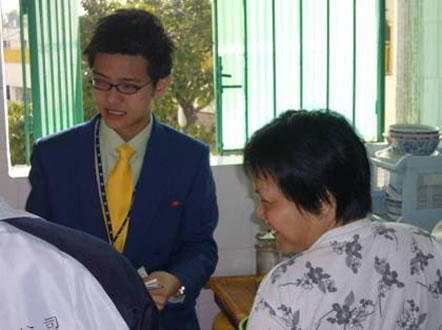

Factory Estates
We have commenced implementation of the Factory Marking Scheme to deal with the irregularities generally found in Housing Authority's factory estates. Penalty points are allotted based on the seriousness of misdeeds and tenancy termination by the Housing Authority will result when 16 marks are allotted within a two-year period.
Our safety and environmental policy also covers hygiene and public health quality. Associated measures improve health among our stakeholders and are tied-in with our safety and environmental initiatives. More specifically, we have implemented the following measures to improve hygiene and health of our stakeholders and mitigate the impacts from our or our contractors' operations:
-
Continued enforcing our measures on anti-mosquito breeding. This includes intensification of inspections by estate management and site supervision staff on mosquito breeding 'black spots'. This year, two convictions were served on one of our contractors for failing to prevent mosquito breeding. Promotion posters and Estate Management Advisory Committee (EMAC) newsletters were also posted and distributed to tenants to raise awareness of anti-mosquito breeding;
-
Continued implementing the Marking Scheme for Tenancy Enforcement, which allotted points to tenants committing identified hygiene and public health misdeeds. In 2005, three PRH tenants had received notice-to-quit s for the tenancy;
-
Spearheaded 'Operation Tai Ping Tei', HKSAR-wide cleansing campaign to promote good personal hygiene practices in public housing estates and encourage tenants to keep estates clean;
-
Continued to implement regulations for keeping dogs in housing estates;
- Prevention of Avian Influenza (see details below );
- Developed a common w-trap system for drainage works to prevent spreading of disease through dried up floor drains for new estates under design; and,
- Undertaking the installation of air conditioner drains
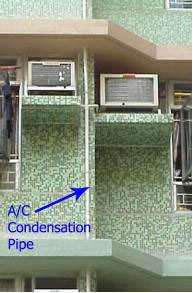
|
We strictly enforced a fixed penalty fine of $1,500 and five demerit points under our Marking Scheme for Tenancy Enforcement. This fine was levied on violators to deter tenants from feeding wild birds in PRH estates which impacts upon public hygiene. We also fenced off open spaces vulnerable to occupation by wild house crows at Lai On Estate and Sham Shui Po for thorough disinfection following a suspected case of H5 avian influenza after a house crow was found dead in the estate. As of this year, we have served 10 convictions for feeding wild birds within the estate premises. |
Our staff are an essential component of achieving our sustainable housing vision. As such we continually strive to ensure that as far as possible they are motivated, efficient and provided with appropriate commensurate benefits.
Beginning in late 2002, Housing Authority has been experiencing reorganization. It is especially important during these times to ensure staff are kept well informed of these developments and that help is provided for coping with and embracing the transition to meet the new service requirements.
We have also conducted various initiatives for HA staff, for example, activities organized by the HA Staff Club, active communication with staff, and obtain feedback to enhance operational effectiveness.
| The 2003 plan requires the Housing Authority to streamline its structure by 30%, i.e. a reduction of around 3,500 posts, over 5 years from 2002 to 2007. In 2005/06, 276 posts were deleted, representing a 3% reduction as of end of March 2005. By end of March 2007, 380 posts are expected to be further deleted through natural wastage. This shall meet the overall target, following which no further significant changes are expected. |
Key developments in 2005/06 include:
- Succession plan development - Candidates identified under this scheme will receive intensive and fast track management and developmental training to ensure that they are ready and available to take on greater responsibilities as and when the need arises;
- With the LINK divestment in November 2005, staff previously engaged in work related to those divested properties have been redeployed mainly to the Estate Management Division;
- Implementation of new human resource-intensive programmes such as the Total Maintenance Scheme and Comprehensive Structural Investigation programme made possible by the redeployments as a result of the LINK divestment and our structural changes;
- Our Training and Development Centre (T&DC) continues to work closely with division heads and different stakeholders to identify training needs and develop training plans, and with line supervisors and staff to improve training programmes; and
- Enhancement of the e-Learning and e-Nomination systems to encourage learning on the web.
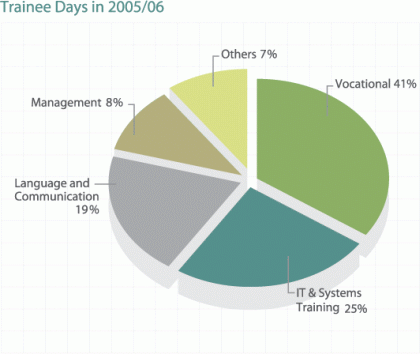
| |
Our e-Learning portal received the internationally acclaimed Excellence in Practice Award in the Learning Technologies Category by the American Society of Training and Development in 2005. |
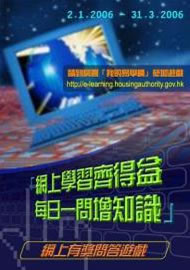 |
| We have worked closely with the Housing Authority Staff Club in launching a series of 'Balance Work - Life' Seminars that included knowledge and experience-sharing with leading specialists and prominent speakers in stress management and health-related issues which helps our staff develop a healthy and supportive work-life perspective. |
During 2005/06, the Housing Authority continues to provide subsidized rental housing to those who cannot afford to rent accommodations in the private market. It also assists Government in maintaining the AWT for PRH at around three years.
| In absolute terms, this means that in 2005/06 we have provided some 41,000 families with new homes through our PRH programme, with around two-thirds of this number being allocated to Waiting List applicants. |
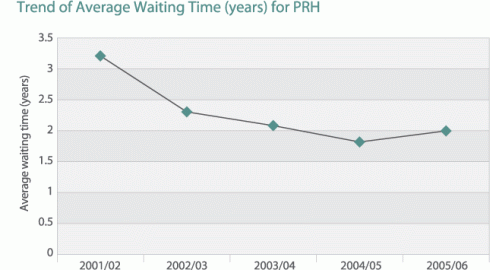
The challenge continues ahead as demand for PRH housing remains very strong, with an average of 3,400 new applications being registered each month and an estimate of around 100,000 applications on the Waiting List.
To ensure housing resources are efficiently allocated, we have effectively utilized the Tenancy Management Module of our Estate Management and Maintenance System. Apart from this, our District Tenancy Management Office and a special unit, the Public Housing Resources Management Sub-section (formerly known as the Task Force Against Abuses of Public Housing Resources ), work closely together and are demonstrating excellent progress and achievements in their work and liaison with other government departments (eg the Police, the Customs and Excise Department, etc.) in ensuring housing resources are appropriately managed and abuse-free.
| • |
Non-occupancy / undue vacancies; |
In particular, during 2005/06, the Task Force:
-
Implemented the policies pertaining to the Housing Subsidy Policy, the Policy on Safeguarding Rational Allocation of Public Housing Resources, the Grant of New Tenancy and other tenancy management policies that covers 160,000 households which is equivalent to a quarter or all PRH households;
-
Conducted in-depth income and assets audits of over 4,200 cases;
-
Detailed investigations of over 5,800 cases of suspected abuse of housing resources;
-
Un-notified audits of 11,000 units in our factory estates suspected of unapproved alterations into units for residential purposes;
-
House visits to Rent Allowance for Elderly Scheme (RAES) recipients living in private housings to prevent abuse; and
-
Investigation into 157 cases of PRH tenants' ownership of private properties.
The work of this task force has increased retrieval of PRH units in 2005/06.
In addition, we have fostered the following schemes to better fulfil our overall goal to provide affordable, sustainable and timely housing for the general public:
- Implementation of three Territory-wide Overcrowding Relief (TWOR) exercises which resulted in the successful re-housing of 1,072 overcrowded families into larger flats, constituting a drop of the total number of overcrowded families to 5,103 as of March 2006. This represents 0.8% of total PRH households, thus meeting our performance pledge to keep this percentage below 1.0%.
- Enhancement of transfer opportunities for tenants by the endorsement of the Living Space Improvement Transfer Scheme, under which tenants living below seven square metres internal floor area per person may apply for transfer to a larger flat. Since the launch of the programme in January 2006, we have received 3,989 applications.
- Endorsement by the Subsidized Housing Committee (SHC) of an annual quota for non-elderly one-person applying for PRH and the establishment of a point system to accord priority to applicants of higher age. Points are assigned to applicants based on age, existing PRH tenancy and accumulated waiting time.
- In December 2005, our SHC decided to further relax the Rent Assistance Scheme (RAS) for tenants with financial hardship. Starting in March 2006 the new eligibility criteria include:
| ° | Consistent criteria for non-elderly households as with those for elderly households; | |
| ° | Rent-to-income ratio being lowered to 'exceeding 20%' from a previous 'exceeding 25%'; |
|
| ° | Tenants having a monthly income below 60% of the Waiting List income limit are eligible for assistance; and |
|
| ° | Cancellation of the three-year residence requirement for households living in older block types in order to be eligible for the RAS. |
Since 2003, we have continued to implement our arrangement for keeping dogs in housing estates. Dogs can only be kept within the housing estates if they have been kept before 1 st August 2003 and with permission of estate office. We released a set of conditions and regulations for fulfilment of dog-owner tenants and ensure safety to other residents, which include hygiene, health and safety issues.
With regard to further enhancing the general quality of living standard in our estates, we have:
- Launched the second phase of the Laundry Rack Subsidy Scheme in April 2005 (under the Housing Department's regime) to assist tenants replace their pole socket facilities;
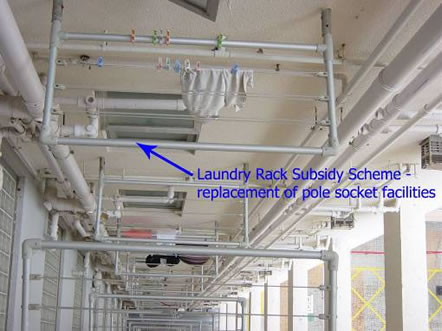
-
Endorsed a number of improvement works for the visually impaired in PRH and Tenants Purchase Scheme (TPS) estates. Works are expected to complete in the next 3 years. These include: tactile guide paths, posting of braille letters in specified areas and provision of dropped kerbs and ramps; and
-
Carried out modifications to suit tetraplegics residents of public housing such as modifications and enlargements of bath and toilet compartments, handrails and railings, adjusting electricity switches for easy use, ceiling mounted hoist at the bed and toilet areas and improving ramp slopes at the entrance of the flat. As of 2005/06, four applicants have been provided flats with these modifications.
Our care to the community also extends to serving the elderly community that resides in our estates. In 2005/06, we:
-
Celebrated the 10 th Anniversary of our Volunteers for Seniors Day, reaching the milestone of 100,000 accumulated voluntary service hours for over 10,000 elderly public housing tenants; and,
-
Organized the Healthy Aging in Public Housing Campaign.
In 2005/06, we regained control of three of our public housing construction projects due to the failure of one of our major contractors to comply with contractual requirements. Among other matters, wage arrears due to workers were controversial and urgent. This .case has alerted us on the shortcomings in the contracting and subcontracting systems throughout the industry.
Both the industry and the public were very concerned about the recent wage arrears cases. The traditional practice of multi-layered sub-contracting often ends up in ambiguous appointment and employment relationships. The lack of formal employment agreements and associated wage records further complicates the situation.
After building on the experience gained in some Government pilot projects, we consulted the industry, including sub-contractors and workers, and have developed improvement measures to secure and monitor the payment of wages to workers which have been adopted in building contracts and nominated sub-contracts from May 2006. We also hope that the building quality and ethical standard of the industry could be enhanced through this initiative.
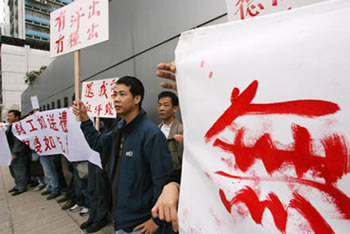
| After intensive liaison with the Labour Department, the Environment, Transport and Works Bureau and industry representatives, we embarked upon a revision of our contractual requirements, with the strong belief that our new tightened measures in the revised requirements shall improve the overall welfare and stability of employment for workers engaged in our sites by the introduction of monitory controls and behavioural incentives in subcontracting practices. |
Our measures include:
-
Mandatory use of Workers Employment Agreements and labour records for all contractor and sub-contractor labour;
-
Wage payment Monitoring System and Records;
-
Paying workers by traceable autopay arrangements;
-
Deployment of Labour Relations Officers to monitor wage payment to workers and receive complaints and inquiries from workers;
-
Authority to deduct relevant sums from contractors for direct payment of wages to workers in proven cases of default; and,
-
Removal from our List of contractors or suspension from tendering for proven defaults under the List Management System.
One important task was to promote awareness of the Housing Authority's improvement measures for securing workers' wage payment among our stakeholders in the industry, especially sub-contractors and workers. As such, a joint working group for securing wage payment to workers has been established in 2006. Its duties include monitoring the implementation of the improvement measures in HA projects; reviewing and recommending further improvement and assisting HA to convey the message that our measures are working to protect workers against wage arrears, as well as protecting contractors and subcontractors from being adversely affected by the problem.
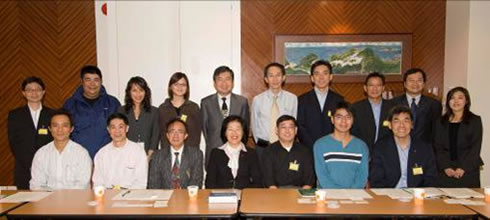
Implementing the Voluntary Subcontractors Registration System and Construction Workers Registration Scheme in Hong Kong would also be vital in enhancing the transparency of the whole industry and will be one long-term fundamental solution.